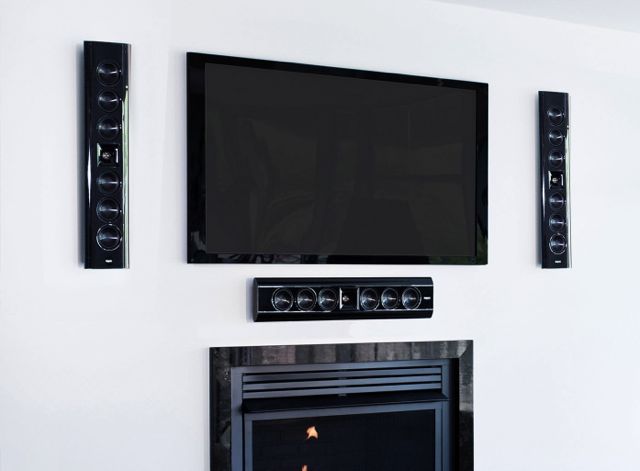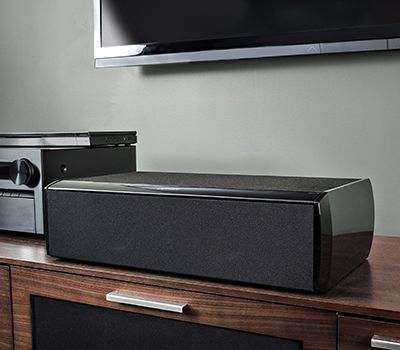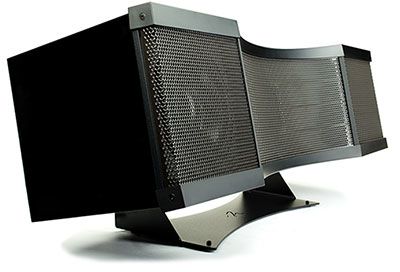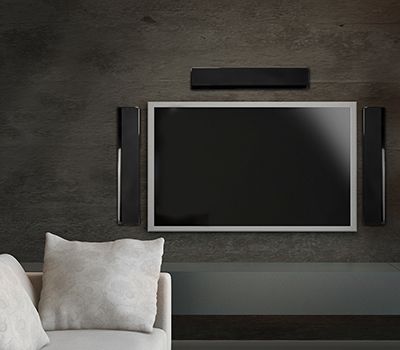 The centre channel is arguably the most important speaker in your home theatre, and placement of it is critical to allow peak enjoyment of your investment. Before we get into the factors that will impact your decision, it may be worth understanding what the centre channel does and why it’s so important.
The centre channel is arguably the most important speaker in your home theatre, and placement of it is critical to allow peak enjoyment of your investment. Before we get into the factors that will impact your decision, it may be worth understanding what the centre channel does and why it’s so important.
What does a centre channel do?
Our centre channel speakers are essential to an immersive home theatre experience because they carry much of the load during a multichannel surround sound movie. All dialogue is directed to the centre channel, as are the majority of on screen effects.
The front left and right speakers drive the stereo soundtrack and like all other speakers in your home theatre are responsible for off-screen effects as well. Based on the amount of work our centre channels are responsible for, many consumers invest big dollars to ensure their centres are up for the task.
How to buy a centre channel
I would highly recommend your centre channel be timber matched to your left and right channels to create a seamless soundstage in your home theatre. When you find a pair of speakers that you love, there will be a centre that was designed to operate in tandem with them, andBest Buy Canada is a great place to find it. I would budget to invest 50% of the cost of your main left and right speakers on your centre channel. (If your main left and right speakers cost $2000, plan to spend $1000 on your centre channel.)
This brings us to the central question of this piece, should the centre channel be placed above or below the monitor, and the answer is a rock solid, “it depends.”
The listening position
Because the role of our centre channel is to amplify such key components of multichannel soundtracks, the placement of the centre is vital. The listening positions, where you and your friends and family will be seated while enjoying your home theatre, is going to determine the ideal centre channel placement. Simply put, to enjoy the magic of home theatre, everyone in the room needs to have a direct line of sight to the centre channel. Without that line of sight, much of the sound being amplified will absorbed by other people or other objects, drastically changing the quality of sound. This is a major consideration for home theatres with tiered seating.
 Tweeters matter
Tweeters matter
The conventional wisdom is that your tweeters on your left and right channels should be at ear level. Check out most floor standing speakers and you’ll note the tweeter placement is pretty standard; when seated, listeners will be at ear level with the tweeter. In an ideal world, the centre channel tweeter would follow suit. However, placing the centre at ear level isn’t always feasible, usually because there is a large screen in the way. In an electrostatic speaker, the entire panel acts as your mid-range and tweeter, and the panels should also be directed at the listening position
Off axis response
 Sound is directional, and there is a dip in the volume or dB a speaker outputs as you move out of its direct path. Your speaker specs will outline what the angles are and the dB loss is, and this is called off axis response. Special floor stands that angle the entire centre channel up to the listening position are used to ensure you aren’t sacrificing power in when the speaker doesn’t fit below the screen at ear level. If mounting above the screen is the route you go, you will want to find a way to angle the speaker down towards the listening position.
Sound is directional, and there is a dip in the volume or dB a speaker outputs as you move out of its direct path. Your speaker specs will outline what the angles are and the dB loss is, and this is called off axis response. Special floor stands that angle the entire centre channel up to the listening position are used to ensure you aren’t sacrificing power in when the speaker doesn’t fit below the screen at ear level. If mounting above the screen is the route you go, you will want to find a way to angle the speaker down towards the listening position.
Wall mounted vs. traditional cabinet
You can imagine it may be difficult to mount a 50 lb. speaker that is designed to sit on a shelf or a special stand six feet off the ground, while angling it back to the listening position. If your speakers are designed to be wall mounted, your placement options open up dramatically. While convenient, wall mounted speakers may sacrifice some audio qualities of a traditional cabinet speaker, so this is all a balancing act of what compromises you are willing to make.
Acoustically transparent screens
There is one scenario where placing a centre channel behind a screen can work, and that is in the event your home theatre uses a perforated projection screen, similar to what is used in modern movie theatres. These screens are designed to allow sound to travel through them, and if you use a projection screen and have the additional space behind the screen to house the speaker, this may be a great option, particularly if you have tiered seating in your theatre.
Aesthetics
Home theatres should be enjoyed, and part of creating a space that screams, “use me!” is designing it to be aesthetically pleasing. Part of your decision making process should involve consideration of what is going to look good. You want to wow your friends when they see your home theatre, and ensure your partner appreciates your design choices as well, and that involves making it look clean and professional.
Where you place your centre channel should be a relatively easy decision, just remember to angle the tweeter back towards the listening positions. If you have space under your TV or projection screen, and there is a direct line of sight from all listening positions by either placing it on a shelf under the monitor or on a floor stand, I would suggest taking the easy route and placing the centre under the screen.
If that line of sight doesn’t exist, or there isn’t any space below, then start considering moving the centre channel above the screen. If you have a wall mountable speaker that may be a simple solution, however, mounting cabinet speakers may present some challenges, perhaps introducing a new question: should I find a way to raise my screen?
You’ll find many centre channel speakers for your home audio needs at Best Buy



